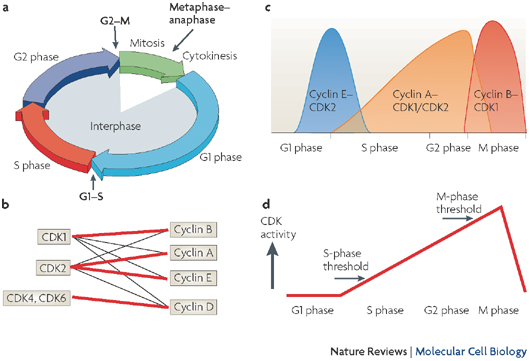Animation:
https://biology-forums.com/index.php?topic=82595All eukaryotes have multiple cyclins, each of which acts during a specific stage of the cell cycle. (In organisms with multiple CDKs, each CDK is paired with a specific cyclin.) All cyclins are named according to the stage at which they assemble with CDKs. Common classes of cyclins include G1-phase cyclins, G1/S-phase cyclins, S-phase cyclins, and M-phase cyclins. M-phase cyclins form M-CDK complexes and drive the cell's entry into mitosis; G1 cyclins form G1-CDK complexes and guide the cell's progress through the G1 phase; and so on.
All CDKs exist in similar amounts throughout the entire cell cycle. In contrast, cyclin manufacture and breakdown varies by stage — with cell cycle progression dependent on the synthesis of new cyclin molecules. Accordingly, cells synthesize G1- and G1/S-cyclins at different times during the G1 phase, and they produce M-cyclin molecules during the G2 phase (Figure 2). Cyclin degradation is equally important for progression through the cell cycle. Specific enzymes break down cyclins at defined times in the cell cycle. When cyclin levels decrease, the corresponding CDKs become inactive. Cell cycle arrest can occur if cyclins fail to degrade.

Where and when do cyclins act on the cell cycle? (A) Cycling cells undergo three major transitions during their cell cycle. The beginning of S phase is marked by the onset of DNA replication, the start of mitosis (M) is accompanied by breakdown of the nuclear envelope and chromosome condensation, whereas segregation of the sister chromatids marks the metaphase-to-anaphase transition. Cyclin-dependent kinases (CDKs) trigger the transition from G1 to S phase and from G2 to M phase by phosphorylating distinct sets of substrates. (B) CDK1 and CDK2 bind to multiple cyclins (cyclin types A, B, D and E), whereas CDK4 and CDK6 only partner D-type cyclins. Thick lines represent the preferred pairing for each kinase. (C) According to the classical model of cell cycle control, D-type cyclins and CDK4 or CDK6 regulate events in early G1 phase (not shown), cyclin E-CDK2 triggers S phase, cyclin A-CDK2 and cyclin A-CDK1 regulate the completion of S phase, and CDK1-cyclin B is responsible for mitosis. (D) Based on the results of cyclin and CDK-knockout studies, scientists have constructed a new threshold model of cell cycle control. Accordingly, either CDK1 or CDK2 bound to cyclin A is sufficient to control interphase, whereas cyclin B-CDK1 is essential to take cells into mitosis. The differences between interphase and mitotic CDKs are not necessarily due to substrate specificity, but are more likely a result of different localization and a higher activity threshold for mitosis than interphase.